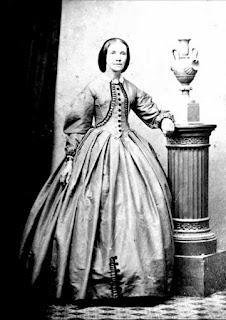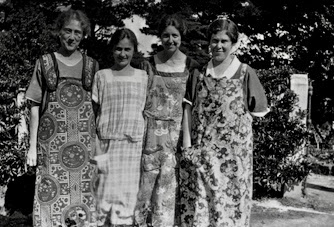26/52 Identity : Elizabeth Ann Best. 1845 -1920
25/52 Identity : Elizabeth Best
Elizabeth and Ezra, twins, were the first children of Anna Maria Humphries and Joseph Best. Joseph was converted to Primitive Methodism as a young man. He was musical, joined a band which took him into bad company. He saw the Light at the age of 21 and started distributing tracts, soon leaving his agricultural village, Durweston in Dorset and becoming an itinerant preacher. In 1844 he married Anna Maria Humphries who was from a Primitive Methodist family. She was 20, he was 31. Two years later with the baby twins he was posted in St Ives, Cornwall as a superintendent. Although women played an important role in the Primitive Methodist church, that being something that distinguished them from Wesleyan Methodists, by 1844 this had been reigned in, especially for married women. So I can’t see Anna Maria with her twins, ministering to the assembled crowds at the open air ‘love feasts’ as they called their meetings. Sunday School was central to the PM calling and both Joseph and Anna Maria would have organised classes for adults and children alike. Primitive Methodism was their identity.
While they were in Saint Ives Anna Maria gave birth to two more babies: Joseph, (1848) and John Humphries (1850,) who grew up to follow his father and became a Primitive Methodist minister at the age of 17.
When the 1851 census was taken Elizabeth was five years old and was staying with her grandmother, Elizabeth (née Beard) Humphries, a widow and a trader. An uncle and two aunts, in their 20s were also living there and a 3 year old cousin. We don’t know if Elizabeth and her cousin were permanently living with their grandmother or if they were just being temporarily cared for.
Elizabeth’s mother died when Elizabeth was 11. Joseph married again the following year. In the next census in 1861 Elizabeth was at boarding school, if you can call it that. It was in Somerset and there seems to have been three fifteen year olds, living in a house with two young servants, a husband and wife in their 60s, their two daughters, aged 22 and 28 and a female boarder, aged 51. What did they learn? Which of these people was the teacher?
Five years later Elizabeth, aged 21, married a Primitive Methodist William Hunt. Both William’s parents were devoted Primitive Methodists, his father a preacher and his mother a class leader. William was ‘on the plan’ when he was 16 years old, worked as a student teacher and became a minister at 18. He was 22 in 1866 when Joseph Best conducted the service to marry William and Elizabeth at the Chippenham Methodist Church.
Joseph Best wrote a hymn to the New Year, 1867 which was published in the Primitive Methodist Magazine. The last verse reads:
Lord Jesus, we shelter in Thee
While toss’d on the billow and wave
of Life, as a tempest-wrought sea
Protect us, deliver and save.
Was he praying for his son, Ezra, tossed on the billows of the Southern ocean, travelling to Australia? Ezra arrived safely in Victoria in February of 1867 where he made a living as a tailor. In September Joseph’s daughter with William Hunt and six month old grandchild, boarded the Glendower in London and set sail ‘on the tempest-wrought sea’ for the colony of Victoria. Their ship carried only 38 passengers. There was another clergyman on board, Irish, so probably Catholic. I wonder how a Primitive Methodist family would have related to an Irish Catholic family on board ship and hope that hardship may have overcome prejudice. Both couples had babies so hopefully the two women supported one another. Mrs Kennedy was ten years older than Elizabeth so perhaps she gave her motherly advice, wanted or not.
William, Elizabeth and baby, Maria, arrived in Melbourne on the 12th of December, 1867 and were soon on their way to the Gold Fields to minister to sinners and devout alike. In April of 1868 Mrs Hunt laid the foundation stone of the Primitive Methodist Church in Service Street, Clunes.
Over the next seventeen years Elizabeth gave birth to six more children, in 1869, 1870, 1872, 1876, 1880 and 1884. The boy born in 1869 died in infancy I believe because I have not been able to find any further references to him. How hard was this when she was so far from home? I imagine she gave it all to God. She was resilient and believed in God’s will and she taught this to her children. She had four girls: Maria, Edith, Mabel and Ethel and two boys, Herbert and Harold, (not counting William, the one who died).
The family was moved every three to five years. They were in Creswick/Clunes (1867 - 1871); Melbourne (1871 -1875); Sandhurst (Bendigo) (1875 -1879); Geelong (1879 -1883); Melbourne (1883 -1886); Ballarat (1886- 1892); Talbot (1892 -1895); Brunswick (1895- 1906); Portland (1906 - 1909) and then Richmond. In 1910 he took on the position of Foreign Missionary Agent, from which position he retired in 1914.
William Hunt has over a hundred mentions in the newspapers but Mrs Hunt is rarely mentioned. Such is the difficulty of researching our grandmothers. In November 1876 Elizabeth is named presiding at a stall at the church bazaar in Sandhurst where one could buy items created by the sewing circle held by the women of the congregation in the months leading up to the fair. It was reported with approval that raising funds by selling items was a better plan than ‘raffling or art-unions [which] are not regarded with favour by many members of the congregation, it being the general opinion that the house of God is no place for such things to take place.’ Opposite the stalls of ‘a thousand and one knick knacks’ was a long table ‘literally groaning under the weight of good things provided for the tea’. They had to have several relays to feed everyone.
In 1882 after fifteen years in Australia, William and Elizabeth travelled home to England to see their families. They took the youngest child with them. It was a quick trip, more time spent travelling than visiting family but it must have been very memorable for the Best and the Hunt families to see each other. William was urged to stay but he decided his home was Australia. In 1899 William went to England again, this time without Elizabeth. He negotiated the financial arrangements for the Australian Primitive Methodist church at a time when they were joining with the Australian Wesleyans and Bible Christians. Elizabeth held the fort in Melbourne, managing the Book Room.
The children grew up to be devout. Maria married a minister and travelled beyond Victoria to South Australia and Western Australia, acting the helpmeet for her husband. Herbert became a Presbyterian minister. Mabel was a teacher and Ladies’ Superintendent at Methodist Ladies College. Edith married at age 44 but was widowed. She married again, aged 64, to a widower, another Methodist Minister. I think Ethel, the youngest, stayed at home and did the housekeeping for her mother, as youngest daughters were groomed to do. That leaves Harold, an insurance clerk.
Ezra, Elizabeth’s twin brother, mysteriously disappeared from the records after his arrival in Melbourne in 1867 but reappeared, to my great delight, in the 1914 Australian census, living near Geelong and working as a tailor. In the absence of any letters or photos can I assume that he was connected to his sister’s family? Did they visit? He outlived his sister by three years but they were buried together, something that supports my hope that they were connected during their lives in Victoria.
In November 1920, to paraphrase the words of the Primitive Methodist Magazine, Elizabeth ‘crossed the river and was conducted to His immediate presence’. Elizabeth and William, her daughters, Edith, Mabel and Ethel and her son, Harold and his family and Ezra Best were all buried in the Boroondara Cemetery in the Wesleyan area. She had faithfully given her seventy five years of life to God’s work: was born into Primitive Methodism, married into it, raised six children in it and worked side by side with William Hunt ministering to their flock throughout Victoria. In the Primitive Methodist Magazine of 1910 there is an obituary to Elizabeth’s sister-in-law, Caroline née Cecil, which perfectly encapsulates how a good Primitive Methodist woman might be remembered.
Mrs. Best was a true housewife, genial, kind, and hospitable. She was her husband’s sympathetic companion and co-worker in all the aims and labours of his long career of high and noble service. A source of strength and comfort to him, both in his early manhood and in his riper years.




Comments
Post a Comment